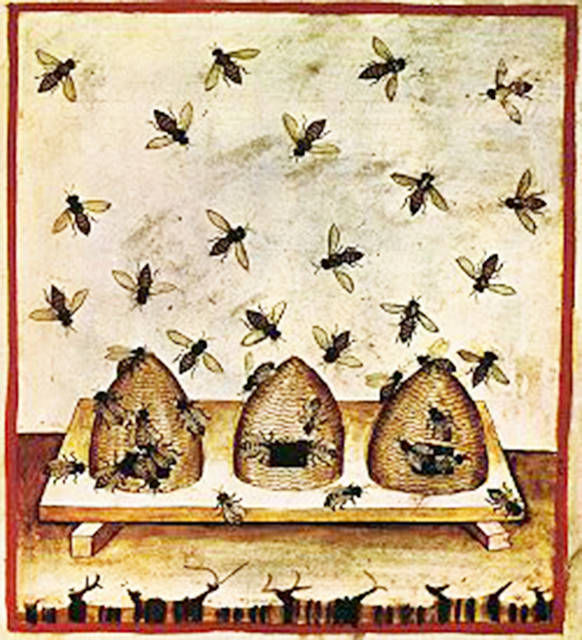Bees and honey have been on my mind as a subject for a Green Flash column since reading “Coffin Road,” Peter May’s Scots novel dealing with the environmental problems leading to the demise of bees, and much before that. “Where
Bees and honey have been on my mind as a subject for a Green Flash column since reading “Coffin Road,” Peter May’s Scots novel dealing with the environmental problems leading to the demise of bees, and much before that.
“Where the bee sucks, // So suck I …” At the time this poem fragment from Shakespeare’s “The Tempest” was hummed to me by my mum on afternoon walks in my childhood, I was aware that it meant something like “Partake of the sweetness of life.” During those walks, we always took notice of plants and flowers, and bees as well as other insects were part of the fabric of those informal botanical lessons.
Now, since the European Union voted to ban the use of chemicals that either kill bees or cause them to forget their way home, and with Canada and the U.S. reassessing agricultural rules, I realize the deeper meaning of what “good Wil” penned four centuries ago: that the very plants bees pollinate are those on which my life —and all other human lives — are dependent.
Before going further, let me say I am not allergic to bee stings. People who are, noticeably duck or wince when buzzed. No wonder, since they have swollen and needed medical treatment after a bee encounter.
Lucky for me, the lesson I was taught has held true: bees (unlike wasps) sting only to protect or preserve their own safety or the safety of their hive. If my life had played out in a different theme, I might have made a good beekeeper. I have thought of bees as being magical helpers since childhood, not only because of my mum’s oft-quoted bee poems, but also because of my love of sweet, natural honey from the first taste of wild honeycomb my dad purchased from Shan villagers, back in Burma.
I’ve always planted bee-attracting flowers, and even encouraged clovers and some weed flowers for that same reason. Years ago, I was photographed kissing a beekeeper as a gag at the Lebanon, Ohio, Honey Festival. The man had a beard of live honeybees because — I learned later — he’d secured a small vial containing bee pheromones under his chin. No stings during that buss (buzz?).
My daughter Angie, who trained as a naturalist, started bee-keeping some years back, setting up hives on a farmer’s land in the Denver-Boulder area. She passed on fascinating information about how she ordered Italian bee queens. They came with “bee guards” for their introduction to the hives, to protect the queens from being killed.
This sounded like a cross between medieval history and sci-fi, to me, but it made sense. We chuckled at the photo of Angie in her bee-keeping outfit when it came time to collect the frames for processing; and we relished the gift of a precious jar of the first batch of amber honey.
It was a sad day when we learned that Angie’s bee colonies were dead or dying from a sneak attach of deadly mites — mites such have stricken apiarists worldwide and including other Hawaiian islands. Strict agricultural rules have prevented the varroa mite from arriving on Kauai, to date.
Beekeepers have been informed on how to keep a constant eye upon their bee colonies for signs of such infestations and other signs that point to health threats.
In January, we talked with mother and daughter beekeepers at the farm market in St. Petersburg, Florida, and bought some of their natural soap byproducts as gifts. We learned that the mother’s bees had recently vanished; the disappearance was tracked to correspond with a campaign to spray weeds in her community. They were pursuing an investigation, certain the bees had “just forgotten” how to fly home to their hives.
Kauai Community College is now offering three Saturday courses in beekeeping. The first session is on maintaining an apiary; the second, on harvesting and extracting honey; the third, hands-on learning about varied hive products — candles to health aids — and how to process. Anyone interested may register through the Office of Continuing Education, 245-8318.
The March session was moved forward: the third Saturdays of April, May and June are now scheduled for the course line, according to KCC’s James Trujillo.
It’s never too late: your Green Flash writer may be attending the next round, once a book project goes to print. My interest continues to be piqued when I attend my Orchestra class rehearsals in the “old elections building” and see bee boxes being built and readied in the vicinity of the KCC Bee Lab and Apiary, next door.
Plus my husband received as a birthday present a most delicious jar of local honey processed by a KCC beekeeper course graduate, and I would like to be able to produce something tangible like this natural sweetener. Also, nowadays we are seeing few bees in our garden, even now, when the Meyer lemons and star jasmine put out their perfumed blooms.
Next time, Green-Flash-ing more why and how to encourage a healthy bee and butterfly garden space or plantings. Meanwhile, we can all keep an eye on environmental news of chemical control measures that affect us as our state and county move forward on pesticide legislation — definitely related to bees and crops on our Garden Island.
•••
Dawn Fraser Kawahara, author and poet, made her home on Kauai in the 1980s. She and her husband, a retired biology teacher, live with books, music and birds in Wailua homesteads. Shared passions are travel and golf. The writer’s books may be found in local outlets and on Amazon. For further information, www.kauaiweddingsandbooks.com.


